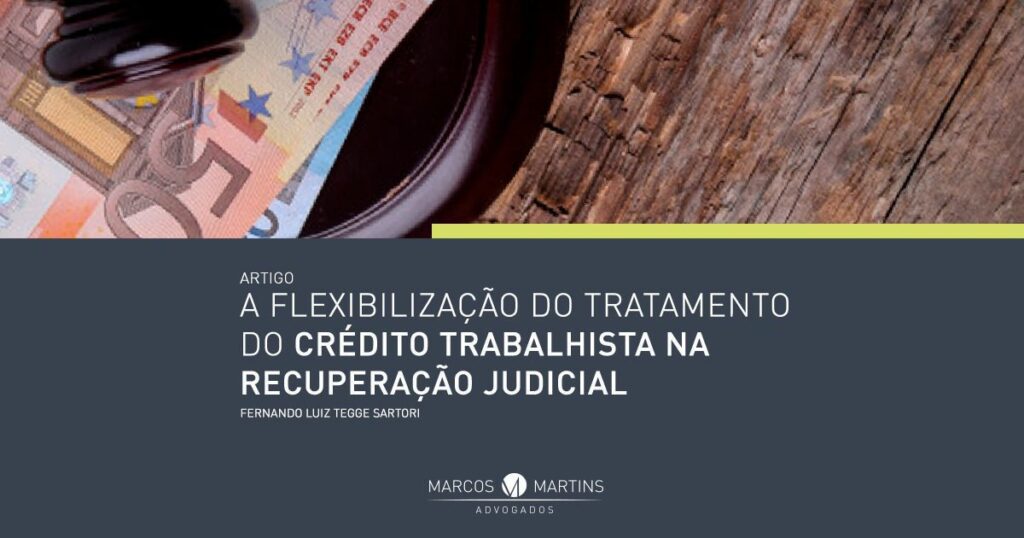Fernando Luiz Tegge Sartori
Lawyer at Marcos Martins Advogados
The judicial reorganization process has increasingly become a viable option for companies wishing to restructure their debts and continue operating in the market.
In the more than 15 years that Law 11.101/2005 has been in force, practice has shown the market that this alternative has become increasingly safe for those who use it, considering the creativity of the professionals involved in this context, as well as the doctrinal and jurisprudential interpretations that have evolved over time.
The truth is that the judicial recovery process could not be analyzed in isolation, with an analysis of compliance with specific clauses, or by analyzing compliance with isolated articles or even from the perspective of a specific interested party.
The evolution of the way in which reorganization legislation is interpreted goes hand in hand with greater specialization on the part of lawyers working in the area, judges, court administrators and representatives of the public prosecutor’s office. Judicial reorganization is no longer interpreted only according to the form of Law 11.101/2005, but rather as a “reorganization system”.
This is because the legislation is no longer analyzed exclusively according to its literal content, but is now analyzed according to its guiding principles and the objective of the legislation, so that many of its rules, over time, have been relaxed in order to achieve the greater objective of the law – the recovery of the business company.
Some of these examples of relativization of the reorganization rule are already common knowledge and widely applied in case law. One of the rules whose relativization is most common is the application of the period for suspension of actions and executions against the debtor, referred to in art. 6, §4 of Law 11.101/2005[1], according to which this period of 180 days is non-extendable.
Despite the apparent rigidity of the wording of the aforementioned article, practice shows that the rule has been relaxed and that the extension of the deadline in Article 6, Paragraph 4 of the LRF is allowed, provided that the debtor has not contributed to delaying the regular course of the proceedings. Considering the significant amounts involved in a judicial reorganization process and the plurality of creditors and other interested parties in the process, it is common for court offices not to keep up with the speed of the process that was envisioned by the legislator.
Another relevant case of relativization of the reorganization legislation is the wording of article 57[2], according to which, in order for the request for judicial reorganization to be granted, the debtor must present negative tax debt certificates.
Despite the specificity of the clause, it has been shown to be dispensable when the judgment approving the judicial reorganization plan and granting the judicial reorganization is handed down, with a consolidated understanding in case law, including in the Superior Court of Justice[3].
In this case, what was found was the existence of a legal antinomy between the provisions of article 57 of Law 11.101/2005, requiring the presentation of a certificate of no debts and the highest principle of the reorganization system – the principle of preserving the company, with the consequent social and economic benefits generated by it. However, considering the objective of the reorganization legislation, case law has consolidated the understanding that it is unnecessary to comply with article 57 of the LRF.
There are many examples of the malleability of recovery legislation when its wording is placed in the light of its objectives and guiding principles.
However, despite all the discussions and interpretations of the legislation that led to the evolution of the reorganization system, one of the points that appeared to be conservative and difficult to make more flexible was the treatment given to labor claims, which are considered to be food claims.
For a long time, no interpretation was accepted other than the literality of the rule contained in the main section of Article 54 of Law 11.101/2005[4], for payment of the full amount of the credit owed to the labor creditor, or equivalent, within one year of the approval of the Judicial Reorganization Plan, or even with an obligation to pay within less than one year, according to the guidance contained in Statement I of the Group of Chambers Reserved for Business Law of the São Paulo Court of Justice[5].
As this is a sum of money considered to be food and due to the privileged treatment that the law itself gives to labor claims, the evolution of negotiation and the search for solutions regarding the renegotiation of this debt has gradually been applied by specialists working in this area.
Negotiation has undergone various attempts to “pierce” the rigidity of the wording of article 54 of the LRF, including the creation of subclasses, the stipulation of a longer term than that established in the legislation, the application of a discount and the application of article 83, I and VI, c), both of law 11.101/2005[6].
In many cases, the Judicial Reorganization Plans have had these clauses annulled, either in acts of legality control by the courts in which the reorganization procedures were being carried out, or in appeals judgments in higher courts. From time to time, these proposals were approved and ratified without any appeals being filed.
In this respect, many of the companies that sought to restructure their debt through judicial reorganization were unsuccessful in overcoming the crisis, largely because it was impossible to negotiate the terms of payment of labor credits. Many other companies didn’t even opt for judicial reorganization, knowing that the legislation was rigid.
In any case, this scenario of business restrictions has been changing, especially due to the combination of the articles of the law and its guiding principles. The fact is that Law 11.101/2005 has a clear objective[7] which should always be considered when analyzing the various controversies and negotiations brought before the judiciary.
Proposals for payment to labor creditors that deviate from the rigid standards established by the reorganization legislation are increasingly common, and these cases have even been approved and the reorganization plans have been complied with.
Along these lines, the Superior Court of Justice recently ruled on the legality of clauses that establish subclasses / maximum levels for labor claims to be considered preferential in relation to other creditors, with the difference being listed for payment under the same conditions as unsecured claims.
SPECIAL APPEALS. JUDICIAL REORGANIZATION. DISCUSSION AS TO THE LEGALITY OF A CLAUSE IN THE APPROVED JUDICIAL REORGANIZATION PLAN THAT ESTABLISHES A LIMIT ON THE AMOUNT OF THE PREFERENTIAL TREATMENT OF LABOR CLAIMS, INCLUDING THOSE RESULTING FROM ATTORNEYS’ FEES, PROVIDED THAT THEY ARE HELD BY INDIVIDUAL ATTORNEYS. 1. JUDICIAL CONTROL OF THE LEGALITY OF THE JUDICIAL REORGANIZATION PLAN APPROVED BY THE GENERAL MEETING OF CREDITORS. POSSIBILITY, IN THEORY. 2. CLAIM ARISING FROM LEGAL FEES. ALIMENTARY NATURE, GIVING RISE TO PREFERENTIAL TREATMENT ON A PAR WITH LABOR CLAIMS. THESIS ESTABLISHED IN A REPETITIVE DECISION. UNDERSTANDING THAT DOES NOT CHANGE DUE TO THE FACT THAT THE DISCUSSION TAKES PLACE IN THE CONTEXT OF JUDICIAL REORGANIZATION; THAT THE HOLDER IS A LAW FIRM; OR THAT THE AMOUNT INVOLVED IS SIGNIFICANT. 3. ESTABLISHMENT OF MAXIMUM THRESHOLDS FOR LABOR AND SIMILAR CLAIMS TO BE GIVEN PREFERENTIAL TREATMENT, WITH THE REMAINDER OF THIS QUANTITATIVE LIMIT BEING CONVERTED INTO AN UNSECURED CLAIM. LAWFULNESS OF THE PROCEDURE. 4. SPECIAL APPEALS DISMISSED.[8]
In the same vein, the Group of Chambers Reserved for Business Law of the São Paulo Court of Justice issued a new statement on the subject, indicating the possibility of applying the condition set out in art. 83, I of Law 11.101/2005 (until then interpreted as applying exclusively to bankruptcy proceedings) to judicial reorganization proceedings:
Statement XIII: In the context of judicial reorganization, the application of the limit of 150 minimum wages, provided for in article 83, I, of Law 11.101/2005, which restricts the preferential treatment of claims of a labor nature (or equivalent), is admitted, provided that this is expressly stated in the judicial reorganization plan and there is approval by the respective class, according to the quorum established by law.
This advance in jurisprudential positioning is beneficial and represents a necessary evolution for the reorganization system, since it demonstrates a real balance between the rights and interests of those involved, so that the judicial reorganization process can be more effective and its objective can be achieved.
Thus, if this condition is provided for in the Judicial Reorganization Plan and is approved at a meeting, there is no obstacle in the legislation for the payment condition to be implemented and complied with by the debtor company.
Marcos Martins Advogados is always attentive to doctrinal and jurisprudential discussions in order to provide the best possible service to its clients.
[rock-convert-pdf id=”13745″]
[1] Art. 6 The decree of bankruptcy or the granting of judicial reorganization shall suspend the running of the statute of limitations and all actions and executions against the debtor, including those of the private creditors of the joint partner. (…) Paragraph 4. ) Paragraph 4. In judicial reorganization, the suspension referred to in the main Section of this Article shall in no event exceed the non-extendable period of 180 (one hundred and eighty) days from the granting of the reorganization proceeding, and the right of creditors to initiate or continue their actions and executions shall be re-established after the expiry of the period, regardless of judicial pronouncement.
[2] Art. 57. After the plan approved by the general meeting of creditors has been attached to the case file, or after the period provided for in art. 55 of this Law has elapsed without any objection from creditors, the debtor shall submit negative tax debt certificates under the terms of arts. 151, 205, 206 of Law no. 5.172, of October 25, 1966 – National Tax Code.
[3] For example, as recognized in the following judgments: (i)BRAZIL. Superior Court of Justice (4th Panel). Special Appeal No. 1.173.735 – RN (2010/0003787-4). Appellants and Respondents: Petróleo Brasileiro S/A Petrobras and Engequip – Engenharia de Equipamentos Ltda. Rapporteur: Justice Luis Felipe Salomão, April 22, 2014; and (ii)BRAZIL. Superior Court of Justice (2nd Panel). AgRg no Agravo em Recurso Especial nº 543.830 – PE (2014/0165586-9). Appellants and Respondents: Blanke Comércio de Pescados Ltda. and Fazenda Nacional. Rapporteur: Justice Herman Benjamin, August 25, 2015.
[4] Art. 54: The judicial reorganization plan may not provide for a period of more than one (1) year for the payment of credits derived from labor legislation or arising from accidents at work due up to the date of the request for judicial reorganization.
[5] The one-year period for the payment of labor and occupational accident creditors, referred to in article 54, caput, of Law 11.101/05, begins on ratification of the judicial reorganization plan or on expiry of the suspension period referred to in article 6, paragraph 4, of Law 11.101/05, regardless of extension, whichever occurs first.
[6] Art. 83: The classification of claims in bankruptcy is in the following order: I – claims arising from labor legislation, limited to 150 (one hundred and fifty) minimum wages per creditor, and those arising from accidents at work; (…) VI – unsecured claims, namely: (…) c) the balances of claims arising from labor legislation that exceed the limit established in item I of the main body of this article.
[7] Art. 47: The purpose of judicial reorganization is to make it possible to overcome the debtor’s economic and financial crisis, in order to maintain the source of production, the employment of workers and the interests of creditors, thus promoting the preservation of the company, its social function and the stimulation of economic activity.
[8] BRAZIL. Superior Court of Justice (3rd Panel). Special Appeal No. 1.649.774 – SP (2017/0015850-3). Appellants and Respondents: Inepar S.A. Indústria e Construções and others and the same. Rapporteur: Justice Marco Aurélio Bellizze, February 12, 2019.








